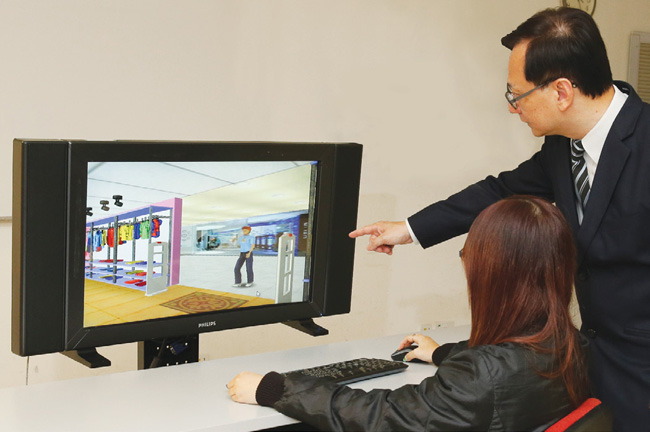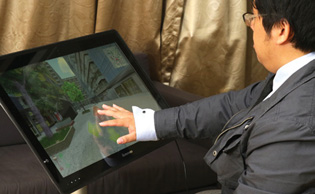people with cognitive deficits

Prof. Man instructs the user to operate the virtual reality based vocational training system (VTVRS) on basic skills as boutique salesperson.
PolyU-developed virtual-reality-based rehabilitation systems help patients to resume their independence and integrate into their communities.
As a cutting-edge technology application to rehabilitation, virtual reality creates a virtual environment (VE) in which near-real training in various scenarios can be provided for patients at different phases of rehabilitation. Some patients with sensory, motor or cognitive disabilities, for instances, encounter difficulties when performing real-life tasks such as navigating transportation and community facilities and shopping. They need a safe, non-threatening environment for developing their independence anew.
Using non-immersive 3D virtual reality technology, Prof. David Man Wai-kwong at PolyU’s Department of Rehabilitation Sciences and his research team have developed computer-assisted rehabilitation systems for patients to acquire community living skills and to provide them with vocational training. They designed the systems with broad use in mind, including for people with cognitive disabilities such as mild cognitive impairment, early dementia, mental retardation, stroke and traumatic brain injury, as well as those lacking work experience or confidence.
The first system, called VRehab, consists of training modules on community living and shopping skills. Using a computer, stereo headset and programmable joystick, patients are required to navigate safely in a virtual environment, travelling on appropriate public transportation, identifying suitable community facilities and shopping according to the needs stated in different scenarios. Using a typical boutique as a work scenario for training, the other system, the Virtual Reality based Vocational Training System (VRVTS), equips users with basic and advanced skills at three levels: pre-trainee, trainee and salesperson.
In addition, the systems recorded user’s performance in required time, accuracy, moving distance and frequency of dangerous actions etc.; user’s difficulties and progress can thus be analyzed.
In these virtual worlds, users not only react to pre-programmed stimuli but also interact with the computer-generated 3D, life-like environment in an entirely new realm of possibility for evaluation and treatment. The systems are now available for further commercialization and product diversification. ♦


